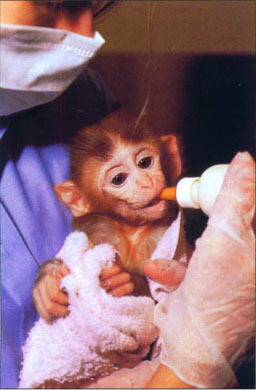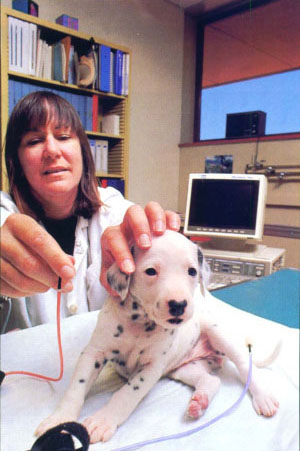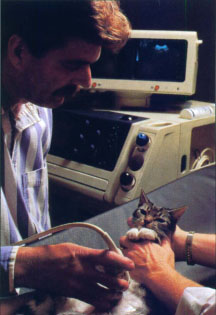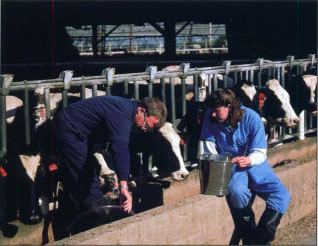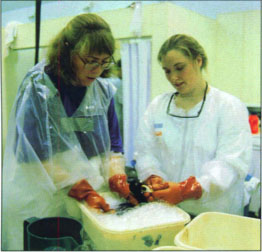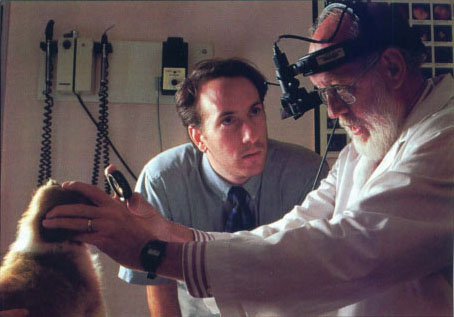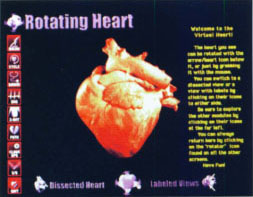All Issues
Growth reflects society's changing views of animals
Publication Information
California Agriculture 52(5):6-9.
Published September 01, 1998
PDF | Citation | Permissions
Full text
The Primate Research Center conducts a wide range of research including nutritional and behavioral studies.
You might say that the School of Veterinary Medicine began on a bet. In the 1930s, Eureka attorney Blaine McGowan approached his state representative, Michael Burns, to find out why his son couldn't find a veterinary school in California. Burns wagered McGowan that California already did have such an institution — a common, though mistaken, belief at that time. (Although animal science programs existed, they stopped short of a veterinary medicine degree.)
After paying for his ignorance with a steak dinner, the legislator introduced a bill which would eventually lead to the creation of the UC Davis School of Veterinary Medicine. Although Governor Olson signed the bill into law on July 9, 1941, the School's progress stalled with the upheaval of World War II. Even during the war, however, interest remained high in veterinary education. Outbreaks of animal diseases — brucellosis, encephalomyelitis, dourine. and other illnesses requiring quarantine or testing programs — were dramatic reminders of the need for a school of veterinary medicine.
In 1944, the UC Regents selected the Davis location, and in 1946 authorized the granting of a doctor of veterinary medicine degree.
One rainy April afternoon in 1948, a few hardy souls, including then-governor Earl Warren, ventured out to break ground. Among the first students to enter that autumn was Blaine McGowan, Jr. — whose father had won the veterinary school bet! He later joined the faculty.
Today as the School celebrates its 50th anniversary, it encompasses more than 30 centers, departments and specialty programs, including the Wildlife Health Center, the Center For Comparative Medicine, the Fish Health Service, the Center for Equine Health, the California Regional Primate Research Center, the Center for Vector-borne Disease Research, the Veterinary Medical Teaching Hospital and other service, research and teaching laboratories.
Pioneers in animal medicine
As early as 1952 the Agricultural Experiment Station and the federal government funded veterinary research studies. By 1963, dozens of research papers were published each year. Faculty pioneered new fields of animal medical care such as surgery, neurology and oncology.
Just a few decades ago, animals were euthanized for a variety of problems now considered treatable. A broken leg used to mean a death sentence for a horse. Now, horses and other animals are treated for broken legs, brain tumors and kidney disease; they benefit from cataract, organ transplant and thoracic surgeries. Clinical “hands-on” experience also advanced veterinary treatments such as livestock vaccines and antibiotics, virtually unknown 50 years ago.
Veterinary scientists also improved understanding of basic animal and human anatomy and physiology, the course of disease in animals and humans and the application of new surgical techniques.
“James Herriott” for companion animals
In the decades between 1960 and 1980, veterinarians played an increasing role in the everyday lives of Americans. Society became more aware of the importance of the human-animal bond, and asserted the intrinsic dignity of animal life. The image of the veterinarian evolved from that of a “James Herriott” figure treating livestock in a rural setting, to that of a companion animal doctor in an urban setting.
The School expanded in several areas. The opening of the Veterinary Medical Teaching Hospital in 1972 added a strong clinical component to companion animal care. Naturally
curring diseases of all classes of animals turned the School into a “teaching laboratory” with real cases and problems to solve. The hospital encouraged development of high-end diagnostic procedures and treatments for animals, such as X-rays and sonograms, enabling students to “see inside” their patients. In addition, private practitioners consulted with faculty. This connection enhanced animal care services throughout the state. The teaching hospital now combines this service and educational function in the largest and most diverse animal specialty program in the nation while treating about 30,000 animal patients a year.
The School's research has benefited humans as well. Small-animal surgeons shared their expertise with large-animal veterinarians and physicians to improve the overall care and management of joint surgeries such as hip replacements. At the California Regional Primate Research Center, studies with primates led to the establishment of California's air quality standards.
Continuing education programs, graduate opportunities, and animal care facilities expanded. The professional student population doubled from 52 students enrolled in 1953 to more than 100 in the early 1960s; enrollment per class now stands at 122 per entering class in the 4-year program, not including residents (about 70), and graduate students.
New teaching strategies
The School initiated a new approach to curriculum as it developed the teaching hospital. Students were able to choose a particular species-related interest, or “track,” and pursue a focused course of study in zoological medicine, food animal studies, small animal specialization, equine medicine, and other areas. Instructors taught in teams, and the students spent their fourth year of training receiving extensive clinical experience.
“The in-depth knowledge and practical clinical skills that these students were able to demonstrate by the end of their fourth year gave UC Davis graduates a competitive edge in the marketplace for several years,” says William Pritchard, dean of the School from 1962—1982. “This new teaching model was soon adopted by virtually every other veterinary school in the United States.”
New veterinary knowledge continued to emerge, sometimes from unorthodox means. ocEmeritus professor Terrell Holliday, cited by colleagues as “the grandfather of neurology,” smuggled small animals into a nearby hospital to use its magnetic resonance imaging machine. Professor Larry Cowgill found and used outdated, surplus human dialysis equipment to treat dogs and cats. His efforts led to the largest veterinary hemodialysis program in the world. Dogs and cats suffering from acute kidney problems such as antifreeze poisoning or chronic kidney ailments benefit from this treatment.
Societal views change
Alongside technical advances, society had begun to evince increased respect for all animals: wildlife, pets, working animals, and animals used for food products. The Center for Animals in Society, begun in 1986, started to document the psychological, emotional and physical benefits of animal ownership: how petting an animal can lower blood pressure and calm older people with Alzheimer's Disease, how hearing-assistance dogs help their owners in social situations, and how spending time with K-9 service dogs at home can improve a police officer's job satisfaction.
Ultrasonic imagery provides information about this cat's pregnancy, but can also supply diagnostic information about tumor growth and intestinal or urinary blockages.
Food safety concerns spurred additional changes. In 1983, the School established the Veterinary Medicine Teaching and Research Center in Tulare County, 250 miles south of Davis — an ideal setting since this county leads the nation in milk production and contributes to California's first-ranking production. The Center provides specialized veterinary training in dairy production medicine. Another new program in the same location, the California Dairy Technology Center, teams up educators from the local high school, the community college, and the School of Veterinary Medicine, to provide science courses, research opportunities and vocational training to students from 9th grade to postdoctoral levels.
Veterinary extension specialists advise livestock producers on disease prevention, production quality control, food safety and animal well-being. Here a student and her instructor examine a cow on a ranch near Davis.
Also during the 1980s, the California Veterinary Diagnostic Laboratory System was established in cooperation with the California Department of Food and Agriculture. Diagnosing livestock disease and preventing its spread is the prime mission; teaching and research are also conducted. Laboratories in Davis, Turlock, Tulare, Fresno, and San Bernardino also contribute to a statewide database of preventive health information.
Systems approach to disease
Veterinary School education, with a faculty-to-student ratio of 1:5, is both labor-and capital-intensive. During the early 1990s, the public education pie shrank, especially in the area of instructional funding, and veterinary medicine felt the pinch. The School adapted to a dip in available public funds of up to 25% by reorganizing departments, seeking private funding sources and developing several new initiatives. New Centers of Excellence advanced a collaborative “systems” approach to disease problems. An early model (1962) was the California Regional Primate Research Center, established at UC Davis by the National Institutes of Health. The Primate Center brought together veterinary, biological sciences and medical faculty to study the effects of environmental changes on primates. In the 1990s, the establishment of the Centers for Equine Health, Companion Animal Health, Food Animal Health, Wildlife Health, Comparative Medicine, Vector-borne Disease Research and other laboratories focused the attention of a broad spectrum of scientific minds on specific issues, species groups and human health problems.
The Oiled Wildlife Care Network has 21 member organizations that respond to oil spills rescuing and rehabilitating injured marine mammals and seabirds.
More effective instruction resulted from the Computer-assisted Learning Facility. Faculty developed and customized 200 interactive software programs that help students tackle specialized knowledge at their own pace. Students may also take on-line quizzes, saving valuable instructional time in the curriculum. The programs are continually and swiftly updated as new findings unfold.
Several other teaching aids emerged at this time to enhance instruction and provide alternatives to the use of animals in teaching. Today, in place of animal organs preserved in formaldehyde, students study organ specimens preserved with liquid silicone. Such specimens are reusable and less toxic; they save human labor and animal life. Artificial bone models help instruct anatomy students. Vascular access mannequins with realistic vein structures now allow students to practice venipuncture (drawing blood or injecting medication into an animal). These new instructional tools reduce the number of animals used in instruction by up to one-third.
New constituents and directions
With advances in companion animal care, pet owners began to demand veterinary services as sophisticated and extensive as could be found in human medicine. More students began to specialize in this area. Today, up to 70% of veterinarians are involved in treating small companion animals.
The gender of the student body has also changed. The first veterinary class of 1948 was entirely composed of men. By the mid-1980s, women across the country were entering veterinary school at a greater rate than their male peers. In 1998, a record number of women were accepted into the School — 80% of the class. This number represents a long-term national trend. The April 24, 1998 edition of the Chronicle of Higher Education reported that women make up 75% of the veterinary students at North Carolina State University and Tufts University.
The School has introduced new specialties and refined others to meet the needs of new constituents: AIDS patients, cancer sufferers, and others with compromised immune systems; children who have become ill or died from food- or waterborne disease (such as was carried by tainted hamburgers and apple juice); genetic specialists seeking to find the functions of gene sequences; government regulators, and animal producers. Faculty have raised the profile of veterinary science in comparative genetics, biotechnology, the ecology of disease organisms, and other areas. Wildlife and environmental advocates, and the general public have asserted the value of preserving biological diversity. The profession protects animals in new stewardship capacities, including studies of the interrelationships among humans, habitats, and wild or domestic animal life.
Finally, veterinary medicine has become more involved than ever in protecting human health.
One medicine
According to Stephen Barthold, veterinary researcher and director of the new (1998) Center for Comparative Medicine, “Humans and animals share the same germs, or closely related ones, in several persistent infectious diseases: AIDS, tuberculosis, malaria, Lyme disease. Investigation of these and other diseases, which have enormous impact on society, benefits both humans and their domestic animals.”
This marriage of medical and veterinary medical disciplines is called “one medicine.” Animal models help scientists integrate knowledge about diseases at the genetic level, where humans, animals, and disease organisms are most similar. From studies of disease processes to the final clinical trials of new drugs designed for human use, veterinary expertise complements and contributes to medical progress.
This student and faculty clinician are able to view the puppy's retina simultaneously through specialized instruments.
Biotechnology tools are helping the veterinary profession assure consumers of a safe food supply. Researchers are unraveling the genetic basis of disease and developing new diagnostic tests, vaccines and therapies which can improve the health of people and animals.
Dean Bennie Osburn explains. “School researchers are now working with federal health agencies to develop a human vaccine against the avian (Hong Kong) flu. At the same time, veterinary scientists will create new animal vaccines. Healthier animals mean better protection against foodborne diseases and improved animal well-being.”
Diabetes management, eye surgery, tumor therapies, kidney treatments and transplants, artificial joint surgeries, diagnostic tests for AIDS, and other medical advances now benefit humans, beloved companion animals and other animal species. In a widening circle of medical advancement, veterinary medicine both contributes to and receives the benefit of these new directions.



